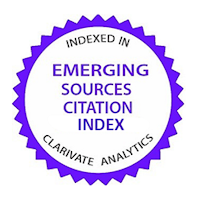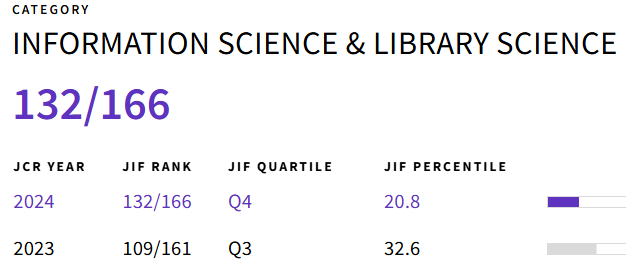Literature and its relationship with other scientific disciplines seen through scientific journals
Abstract
Among the scientific methodologies used to measure the Science, the Social Network Analysis (SNA) is considered a very useful means to assess the quality of the networks established by the Science. The SNA offers the possibility of simulating the relationships established by different factors, such as the scientific collaboration, the analysis of subjects, or the relationships of scientific journals. The Arts & Humanities Citation Reports (A&HCI) and Emerging Sources Citation Index (ESCI) databases of the Web of Science (WoS) have been selected as sources of information. From these databases, we analyze the behavior presented by the 550 journals classified in the different thematic categories of literature. It is proven that the current interdisciplinarity in literature results from collaboration with 11 other scientific branches, among which linguistics and history stand out.
Downloads
Metrics
-
Abstract2324
-
PDF (Español (España))4487
References
AKSNES, D.; OLSEN, T. y SEGLEN, P. Validation of bibliometric indicators in the field of microbiology. A Norwegian case study. Scientometrics, 2000, vol. 49, nº 1, p. 7-22.
BORDONS, M. y ZULUETA, M.A. La interdisciplinariedad en los grupos españoles de investigación en el área cardiovascular. Revista Española de Cardiología, 2002, vol. 55, nº 9, p. 900-912.
BROADUS, R.N. The Literature of the Social Science: A Survey of Citation Studies. International Social Science Journal, 1971, vol. 23, p. 236-243.
EUROPEAN COMMISSION. Towards a European research area. Luxemburgo: European Commission, 2000.
GIBBONS, M. et al. The new production of knowledge. Londres: Sage, 1994.
GONZÁLEZ ALCAIDE, G. y GÓMEZ FERRI, J. La colaboración científica: principales líneas de investigación y retos de futuro. Revista Española de Documentación Científica, 2014, vol. 37, nº 4, e062. Disponible en: http://dx.doi.org/10.3989/redc.2014.4.1186.
KATZ, J.S. y HICKS, D. The Classification of Interdisciplinary Journals: A new approach. Proceedings of the Fifth Biennial Conference of the International Society for Scientometrics and Informatics. USA: River Forest, 1995.
KLEIN, J.T. Interdisciplinary needs: the current context. Library Trends, 1996, vol. 45, p. 134-135.
LAGAR-BARBOSA, M.P.; ESCALONA-FERNÁNDEZ, M.I. y PULGARIN, A. Análisis de la interdisciplinariedad en la ingeniería química universitaria española. Revista Española de Documentación Científica, 2014, vol. 37, nº 1, e029. Disponible en: http://dx.doi.org/10.3989/redc.2014.1.1048.
LEYDESDORFF, L. y RAFOLS, I. A global map of science based on the ISI subject categories. Journal of the American Society for Information Science and Technology, 2009, vol. 60, nº 2, p. 348-362.
METZGER, N. y ZARE, R.N. Interdisciplinary research: from belief to reality. Science, 1999, nº 283, p. 642-643.
MENDOZA, L. Formación humanista e interdisciplinariedad hacia una determinación categorial. En: R. MAÑALICH, Didáctica de las humanidades. La Habana: Pueblo y Educación, 2005.
OSCA-LLUCH, J.; VEYRAT, A. y MORALES, J. El consumo de información en Humanidades. Arbor, 2013, vol. 189, nº 760, a026. Disponible en: http://dx.doi.org/10.3989/arbor.2013.760n2012.
PEÑARANDA-ORTEGA, M.; QUIÑONES-VIDAL, E. y OSCA-LLUCH, J. Construcción de una metodología para el estudio de la interdisciplinariedad en psicología. EduPsykhé, 2011, vol. 10, nº 1, p. 97-115.
PORTER, A.L. y CHUBIN, D.E. An indicator of cross-disciplinary research. Scientometrics, 1985, vol. 8, p. 161-176.
RUSSELL, J.M.; MADERA JARAMILLO, M.J. y AINSWORTH, S. El análisis de redes en el estudio de la colaboración científica.
REDES- Revista hispana para el análisis de redes sociales, 2009, vol. 17#2. Disponible en: http://revista-redes.rediris.es.
SCHWARTZ, G.A. y BERTI, E. Literatura y ciencia. Hacia una integración del conocimiento. Arbor, 2018, vol. 194, nº 790, a481. Disponible en: https://doi.org/10.3989/arbor.2018.790n4006.
TERRÓN BLANCO, J.L. et al. La interdisciplinariedad en los artículos de comunicación de las revistas de salud pública de Scielo. Communication Papers, 2018, vol. 7, nº 13, p. 31-53.

This work is licensed under a Creative Commons Attribution 4.0 International License.
Las obras que se publican en esta revista están sujetas a los siguientes términos:
1. El Servicio de Publicaciones de la Universidad de Murcia (Editum) conserva los derechos patrimoniales ('copyright') de las obras publicadas, y favorece y permite la reutilización de las mismas bajo la licencia de uso.
2. Las obras se publican en la edición electrónica de la revista bajo la licencia Creative Commons Atribución Internacional CC BY 4.0. Se puede copiar y redistribuir el material en cualquier medio o formato y remezclar, transformar y crear a partir del material para cualquier finalidad, incluso comercial.






